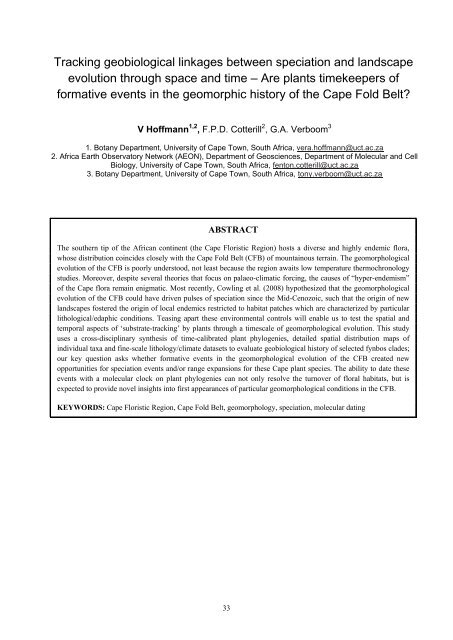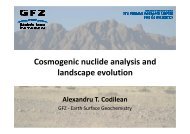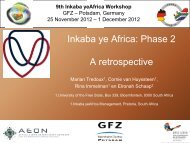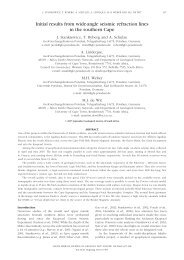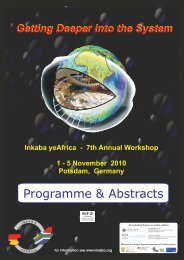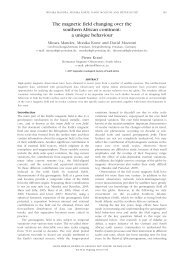South Africa - Inkaba.org
South Africa - Inkaba.org
South Africa - Inkaba.org
Create successful ePaper yourself
Turn your PDF publications into a flip-book with our unique Google optimized e-Paper software.
Tracking geobiological linkages between speciation and landscape<br />
evolution through space and time – Are plants timekeepers of<br />
formative events in the geomorphic history of the Cape Fold Belt?<br />
V Hoffmann 1,2 , F.P.D. Cotterill 2 , G.A. Verboom 3<br />
1. Botany Department, University of Cape Town, <strong>South</strong> <strong>Africa</strong>, vera.hoffmann@uct.ac.za<br />
2. <strong>Africa</strong> Earth Observatory Network (AEON), Department of Geosciences, Department of Molecular and Cell<br />
Biology, University of Cape Town, <strong>South</strong> <strong>Africa</strong>, fenton.cotterill@uct.ac.za<br />
3. Botany Department, University of Cape Town, <strong>South</strong> <strong>Africa</strong>, tony.verboom@uct.ac.za<br />
ABSTRACT<br />
The southern tip of the <strong>Africa</strong>n continent (the Cape Floristic Region) hosts a diverse and highly endemic flora,<br />
whose distribution coincides closely with the Cape Fold Belt (CFB) of mountainous terrain. The geomorphological<br />
evolution of the CFB is poorly understood, not least because the region awaits low temperature thermochronology<br />
studies. Moreover, despite several theories that focus on palaeo-climatic forcing, the causes of “hyper-endemism”<br />
of the Cape flora remain enigmatic. Most recently, Cowling et al. (2008) hypothesized that the geomorphological<br />
evolution of the CFB could have driven pulses of speciation since the Mid-Cenozoic, such that the origin of new<br />
landscapes fostered the origin of local endemics restricted to habitat patches which are characterized by particular<br />
lithological/edaphic conditions. Teasing apart these environmental controls will enable us to test the spatial and<br />
temporal aspects of ‘substrate-tracking’ by plants through a timescale of geomorphological evolution. This study<br />
uses a cross-disciplinary synthesis of time-calibrated plant phylogenies, detailed spatial distribution maps of<br />
individual taxa and fine-scale lithology/climate datasets to evaluate geobiological history of selected fynbos clades;<br />
our key question asks whether formative events in the geomorphological evolution of the CFB created new<br />
opportunities for speciation events and/or range expansions for these Cape plant species. The ability to date these<br />
events with a molecular clock on plant phylogenies can not only resolve the turnover of floral habitats, but is<br />
expected to provide novel insights into first appearances of particular geomorphological conditions in the CFB.<br />
KEYWORDS: Cape Floristic Region, Cape Fold Belt, geomorphology, speciation, molecular dating<br />
33


